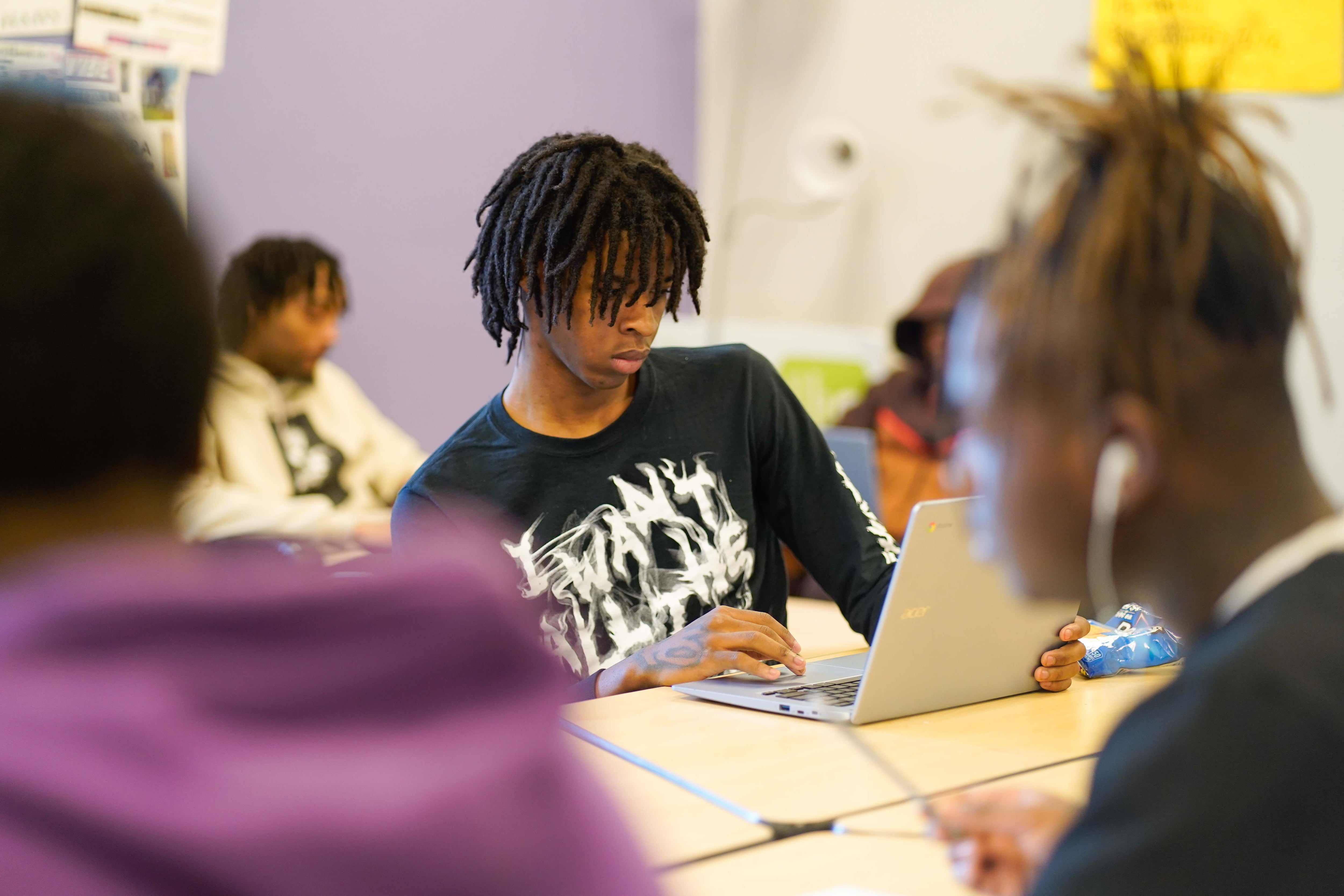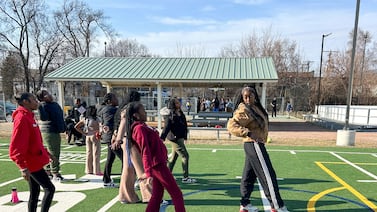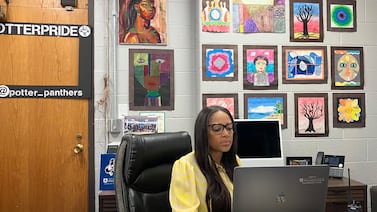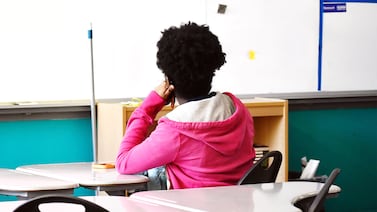Sign up for Chalkbeat Chicago’s free daily newsletter to keep up with the latest education news.
A Chicago Public Schools program that set out to reel back students who hadn’t attended school a year or longer is ending — training a spotlight on both the promise and hurdles of reengaging these young people.
Since its launch during the pandemic, district leaders have touted Back to Our Future as a trailblazing initiative to reconnect with some of Chicago’s 45,000 teens and young adults who are not in school or the workforce — a goal seen as key to reducing gun violence and poverty. At a price tag of $18,000 per student, the program offered a chance to catch up on high school credits, therapy, job training, and a stipend.
But the program was beset by problems from the get-go, a Chalkbeat analysis of data and correspondence shows.
Only about half of the 1,000 students the program set out to reach actively participated over the past two years — and some had not actually dropped out of high school, but had struggled with spotty attendance. Fewer than 60 have earned a high school diploma, while about 160 are currently enrolled or pursuing a GED.
Early on, recruitment proved difficult. For young people who did enroll, online credit recovery software was not yet in place, and there was no clear process for re-enrolling students back in school once they were ready to transition. Six months into the program’s launch, the state issued a formal improvement plan. More recently, it continued to voice concerns about tracking student outcomes.
Still, some argue each student served was worth the effort.
“There’s so much you don’t see if you are just looking at the numbers,” said Myisha McGee, the postsecondary high school director at the nonprofit Breakthrough Ministries, one of the district’s partners.
Jadine Chou, the CPS safety and security chief, said the district knew the initiative would be challenging: It targeted young people with extremely high needs that districts across the country have often written off. For hundreds, it did offer a path to graduation, jobs, and relationships with caring adults.
“This was very hard, and yet at the same time, these students all deserved all of the effort that went into it,” she said. “And I think over the long run, the outcome will show this was absolutely worth all of that work.”
Now, the city, district, and state are in talks about launching a new version of Back to Our Future, which officials say will draw lessons from the original program. The idea is to provide even more — and more personalized — services to its participants.
The mayor’s office did not respond to multiple requests for more information about efforts to relaunch Back to Our Future.
Back to Our Future had a slow start
CPS kicked off Back to Our Future in May 2022 with an $18 million grant from the state Department of Human Services’ Office of Firearm Prevention and some philanthropic dollars. The goal was to reach 1,000 youth ages 14 to 21 in 15 neighborhoods on the South and West sides who had stopped going to school 18 months prior or longer.
The district enlisted three community-based nonprofits — Breakthrough, UCAN, and Youth Advocate Programs — to recruit participants and provide 20 hours of services a week over their initial 12 weeks in the program. The three signed one-year contracts for up to $20 million in total. Students would have the opportunity to get their diploma by completing a credit recovery program. Some might earn their GEDs or make their way back to a CPS school.
The University of Chicago Crime Lab was another key partner, tracking and analyzing student outcomes pro bono. The lab’s research has shown that 90% of school-aged gun violence victims in Chicago were not going to school when they were shot.
Recruiting students was slow-going in 2022. One issue was that amid a push to quickly enlist participants, the district and its partners relied heavily on district lists of students who had dropped out. But contact information didn’t always work, and the outreach could feel more impersonal. More informal outreach using the nonprofits’ ties in the targeted neighborhoods was more effective, according to a report by Crime Lab.
Later that fall, a Crime Lab analysis showed that the majority of students who did enroll in the program were actively enrolled in school. That December of 2022, roughly six months after the program’s launch, the Department of Human Services put it on a corrective action plan, noting that only about 125 youth had signed up. The state also hadn’t yet seen a consistent model for running the program that all three nonprofits could follow.
CPS launched a marketing campaign on radio, social media, and CTA buses, along with other steps to boost recruitment. Enrollment in the program picked up.
But emails obtained by Chalkbeat suggest recurring friction between the district and DHS, with repeated emails in which the state demanded data and documentation on the program’s outcomes. At least at one point, the state temporarily cut off payments to the district for failure to submit required reporting on time.
In the summer of 2023, LaTanya Law, the DHS point person on the program at the time, looped in Jennifer “Jen” Johnson, Chicago’s deputy mayor for education, youth, and human services, in an email, saying: “Hopefully we can move the needle so we can make any adjustments needed to improve the program.”
Recruitment and attendance issues persisted
In early 2023, the district tried to get some outside help. The program enlisted Leo Smith, director of policy at the violence prevention nonprofit Chicago CRED, to consult on improving it.
In an interview, Smith said he agreed that the program needed a more consistent model for the three nonprofits and more of a focus on therapeutic interventions, including the cognitive behavioral therapy the program provided. Some young people stopped attending once a stipend the program offered ran out, suggesting a need to extend these payments or trail them off more gradually.
“It’s incredibly hard to find kids and engage them,” he said. “But when you do, it can be powerful. Kids do turn their lives around.”
Some of the issues with recruitment and attendance persisted, however. In July 2023, DHS and CPS officials discussed a 60-day “reset” that would involve pausing new recruitment while examining the program’s challenges and ways to improve it. The state flagged that many program participants were logging in significantly fewer than the 20 intended hours a week in the program, and many were not getting cognitive behavioral therapy and other mental health support — what Chou had described as the program’s “secret sauce” to school board members. Crime Lab eventually found that in the program’s first year, students logged in seven hours a week on average.
That fall, school board members voted unanimously to renew the contracts for Back to Our Future for another year. They praised the program as a move away from a punitive or at best disinterested approach to students who struggle — with little discussion of its challenges.
“This is a good example of when we are collaborative within CPS and with other public agencies, when we provide high intensity support and recognize that what students need is beyond what sometimes is available in the classroom,” said Jianan Shi, then the school board president.
Ushering students to graduation was challenging
Tiana Williams, 19, said Breakthrough reached out to her family in spring 2023 to pitch the program to her sister, who was not interested. Williams was not exactly the program’s target audience: She was in her senior year at Pathways in Education, an alternative high school. But she was looking at the possibility of doing summer school to finish her studies, and found out she could do that in the Back to Our Future program instead — and receive a stipend while she was at it.
“I am a teenager who wants to make money but also stay focused on school,” she said. “The weekly stipend might not seem like much but it helped a lot.”
She said she liked the online credit recovery program — earning her handful of remaining credits at her own pace, in a smaller, more intimate setting, and eventually graduating. She also took arts and music classes and went on field trips, such as a visit to Malcolm X College.
Williams said she is in between jobs now after working at Walmart following the program, and she is considering applying to college.
But Crime Lab’s report found the credit recovery software was not a good fit for most students without robust in-person support.
Indeed, it doesn’t appear CPS had a clear plan for shepherding the students to their high school graduation, beyond the online program. Even that program wasn’t in place at first. Chicago Public Schools provided it to Breakthrough some two months after participants started arriving. That meant some were at the end of their 12 weeks of receiving a stipend when they started making up credits.
Documents show the district would not formally spell out a process for Back to Our Future referrals to alternative high schools — essentially ensuring that both nonprofits and schools were prepared to provide a smooth transition for students — until January 2024, more than 18 months after the start of the program.
Officials at one network of alternative high schools, Youth Connection Charter School, had been frustrated that the district did not engage it in the program from the get-go. Some of these schools had seen enrollment plummet during the pandemic, and re-enrolling dropouts through the program could give them a boost.
In the late fall of 2023, some Breakthrough students enrolled in a couple of the network’s campuses, most through a connection the nonprofit happened to have with one of them. But the schools didn’t know much about the program; it didn’t make for the smoothest handoff, said Sheila Venson, the network’s head.
Then, Venson said, a principal at one of the schools was invited to a graduation ceremony the district hosted for Williams and 17 other Back to Our Future students. With TV cameras trained on them, the students — wearing moss-green caps and gowns — walked across a stage and later flipped tassels on their caps to raucous cheers.
“We are so excited for the graduation today because every single young person who walked across the stage today completed the program, but even more importantly got a CPS diploma,” Chou told attendees.
But Venson said that the YCCS principal was confused: “Why are these kids in the booklet as graduating? They are not graduating. They are still with us.”
Chicago Public Schools said the 18 students in that ceremony had earned enough credits to graduate but had not yet met other senior requirements, such as attending a senior seminar, completing their senior portfolio, or filling out the FAFSA form. All but one have since done so and gotten their diplomas, the district said.
Days after the release of its policy brief this past January, Crime Lab pulled out of the program, though a data analyst stayed on past that point. Crime Lab said the decision came after a conversation with CPS about “the highest-priority activities and partnerships needed for the program to be successful.”
The program took on an important challenge, Crime Lab said in written responses to questions. It also said that verything from youth concerns about safety to scheduling conflicts with jobs and caretaking got in the way of getting a diploma through the program. But one thing is clear: To help improve youth outcomes and reduce gun violence, helping them graduate from high school — which markedly reduces a young person’s odds of incarceration — is key.
Overall, CPS said, 636 students agreed to take part in the program over its two years. About 100 dropped out, though the district and its partners continue trying to reengage them. Some moved or signed up for other youth programs; 10 were incarcerated, and four died. One hundred and fifty remain connected to the program with “intermittent participation” while 73 are still actively involved in it. Almost 40 landed permanent jobs. The district did not specify, but based on previous data it provided to the state, the majority of the 58 students who graduated got their diplomas at alternative high schools.
Chou said there were never conflicts with the partner agencies on the program and both the state Department of Human Services and Crime Lab remain close collaborators.
She noted that some of the participants were younger and behind on credits, so they understandably need longer to finish their studies; others were older and had aged out of CPS. Still, for some, the program accomplished the tough task of reconnecting them to school. The district also got valuable input from students on why they disconnected that will help the district’s efforts to prevent dropout.
“Students told us, ‘I was made to feel like I couldn’t succeed,’ and to hear that over and over again from the students we are here to serve is a very important lesson for the district,” Chou said.
‘Many improvements we want to make’
Shyvone Leeks said her son was also attending school and had largely completed his high school credits when he applied for the program. After his probation officer recommended it, the family agreed it might offer a positive, supportive environment while he worked out his next steps.
“It was something different,” she said. “I told him he might as well try it out.”
Her son loved the program, Leeks said: He felt safe there and made friends. The stipend was a draw for him and for several friends he helped recruit to Back to Our Future. After the stipend ended, he found a restaurant job. But he recently was arrested on a weapon violation and incarcerated.
“It was a good program,” Leeks said. “I just wish it was a little longer.”
The state did not extend its contract with CPS to continue the program after it ended back in June. In the program’s first year, the state granted $8.1 million, which was later reduced; the district submitted invoices for $2.2 million. In the second year, the district spent about $5.5 million of another $8.1 million grant.
A state spokeswoman said the contract for the program simply ended when it was slated to end.
“Our dedication to this effort is unwavering, and we are optimistic about the future possibilities for continuing the type of impactful work initiated through the Back to Our Future program,” the spokeswoman said in a statement.
In May, CPS officials told the school board that the district would wind down the program, using philanthropic dollars to ensure that students in the program could finish it out. They said they were discussing a new version of the program with city officials, who see reengaging dropouts as a key violence reduction strategy.
McGee, Breakthrough’s postsecondary high school director, said the Garfield Park nonprofit continues to serve some students in a scaled-back program with private funding, though it no longer offers stipends — and hopes to be involved in its next version.
“I think despite the slow start, the program was very, very beneficial to the students who participated,” she said. “We are honestly changing their trajectory.”
Twenty-two Breakthrough students graduated from Progressive Leadership Academy, a YCCS campus. Another student got a degree through the online credit recovery program, and one earned a GED. Five are attending CPS this fall.
McGee holds up Alonte Wilson, a student Chalkbeat featured in a story last summer about efforts to reengage youth, as an example of a young person who turned his life around. He came to the program after dropping out, getting shot, and later getting arrested. He graduated and now works as a teacher assistant at Breakthrough and is a role model for younger students, McGee said.
She said she wishes there were a number of campuses that had been prepared to seamlessly enroll returning students, including some schools closer to the Garfield Park neighborhood than the Southwest Side alternative school.
The new version of Back to Our Future might still use an online credit recovery program — a promising option for students who can’t safely go back to school or don’t want to go back — but paired this time with more individualized mentoring and academic support, Smith of CRED said. The cost of the new program might be closer to $25,000 per student.
Chou said the end of state funding presented an opportunity to pause and rethink some aspects of the program. For instance, she now believes the program should broaden the definition of the students it targets, to include some chronically absent students. The program should also be better prepared to help with a range of needs, including housing and child care. She said she believes the district will continue to play a key role.
“I don’t want to keep feeding into the current version of it when we know there’s so many improvements we want to make,” she said.
Mila Koumpilova is Chalkbeat Chicago’s senior reporter covering Chicago Public Schools. Contact Mila at mkoumpilova@chalkbeat.org.






